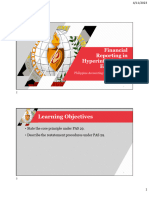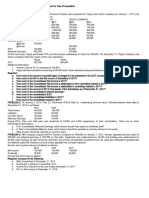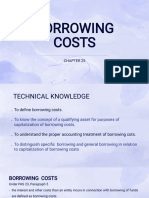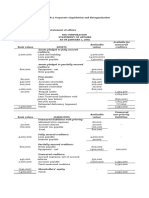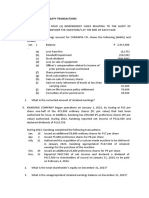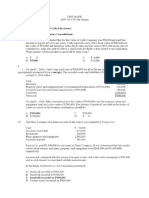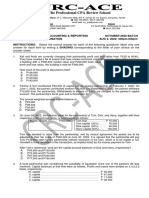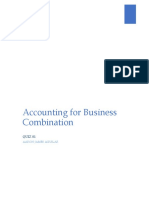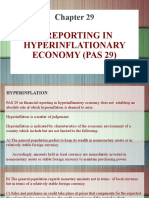0 ratings0% found this document useful (0 votes)
969 views35 pagesChapter 22 (With Problems)
valix vol 3
Uploaded by
Abigail PadillaCopyright
© © All Rights Reserved
We take content rights seriously. If you suspect this is your content, claim it here.
Available Formats
Download as PDF or read online on Scribd
0 ratings0% found this document useful (0 votes)
969 views35 pagesChapter 22 (With Problems)
valix vol 3
Uploaded by
Abigail PadillaCopyright
© © All Rights Reserved
We take content rights seriously. If you suspect this is your content, claim it here.
Available Formats
Download as PDF or read online on Scribd
You are on page 1/ 35
CHAPTER 29
HYPERINFLATION
TECHNICAL KNOWLEDGE
To know the characteristi.
‘ 7 cs that may indicate
hyperinflationary economy,
To know. the requirement for financial reporting in a
hyperinflationary economy.
To understand constant peso accounting.
To distinguish between monetary items and nonmonetary
items.
To know the procedures for restating historical financial
statements in terms of current price level.
To determine gain or loss on purchasing power.
671
HYPERINFLATION
rting in a hyperinflationary econo
PAS 29 on financial repo! psolute rate at which hyperinflation
does not establish an @
is deemed to arise.
Hyperinflation is a matter of. ‘judgment.
i ion is indi 5 Yr istics of the econom;
erinflation is indicated by characteris economia
eo tsoament of a country which include but are not limited )
the following:
lation prefers to keep its wealth in
a. The general popul: A
7 ets or in relatively stable foreign
nonmonetary ass
currency.
Accordingly, amounts held in local currency are immediately
invested in nonmonetary assets or stable foreign currency
to maintain purchasing power.
b. The general population regards monetary amounts not in
terms of local currency but in terms of a relatively stable
foreign currency.
c. Sales and purchases on credit take place at prices that
compensate for the expected loss of purchasing power
during the credit period even if the period is short.
d, Interest rates, wages and prices are linked to a price index.
e. Ae cumulative rate over 3 years is approaching or exceeds
0%.
Although PAS 29 sets out the characteristics that may indicate
hyperinglationary economy, it also states that judgment may
e used in determining wheth ial
stltohients is seaaina ler restatement of financl
672
Financial Yeporting in a
L
PAS 29, Paragraph 8, provi
an entity that reports j
t
economy, whether the
or a current cost appre
measuring unit current
Presentation of the inform
supplement to yn;
permitted,
———
inflationary economy
ides that the financial statements of
© currency of a hyperinflationary
ased on historical cost approach
» shall be stated in terms of the
at the end of reporting period.
ation required under PAS 29 as a
restated financial statements is not
by ciple ep inaneial statements of an entity that reports
by means of constant ypetinflationary economy is accomplished
_ ‘Pe80 accounting and current cost accounting.
Constant peso accoun
Constant peso accounting
iting
is the restatement of conventional
or justorteg! financial statements in terms of the current
purchasing power of the peso through the use of index number.
Constant peso accounting also known as purchasing power
or price level accounting.
‘The traditional concept of pi
on historical cost is known
Monetary items
reparing financial statements based
as nominal peso accounting.
PAS 21 defines monetary items as money held and assets and
liabilities to be received or paid in fixed or determinable amount
of money.
The essential feature of a monetary item is a right to receive
or an obligation to deliver a fixed or determinable amount
of money,
In simple language, monetary items refer to cash and assets
that represent a fixed amount of pesos to be received, or
obligations that represent a fixed amount of pesos to be paid.
Monetary assets and liabilities remain the same regardless of
‘he change in the general price level.
673
Nonmonetary items
ms, by the P’
items that cam
rocess of exclusion, may
Nonmonetary ite not be classified as monetary
defined as those i :
alled nonmonetary ecause their pe
he financial statements differ from 7
ly realizable or payable.
These items are 80 U
amounts reported in tl
amounts that are ultimatel
The essential feature ofa nonmonetary item is the absence of
a right to receive or an obligation to deliver a fixed o
determinable amount of money.
What items are restated?
Only nonmonetary items are restated when preparing constant
peso financial statements.
Monetary items are not restated anymore because they are
automatically stated in terms of current purchasing power of
the peso.
The objective of constant peso accounting is to report elements
of the financial statements in terms of pesos that have the same
purchasing power.
Formula for restatement
Index number at end of reporting period
«Historical cost
Index number on acquisition date
For example, a land was acquired on January 1, 2019 for
P500,000 when the index number is 125.
If the land is to be restated on December 31, 2020 when the
index number iis 300, the restated amount is computed 4
follows:
Restated amount = 300/125 x P500,000
=. P1,200,000
674
y OO —_—
!
Examples of mo,
netary and nonmonetary items
Following is a list 7
with thei of statement of financial position items
ar Proper ifieati,
Per classification ag monetary or nonmonetary-
Cash Monetary Nonmonetary
Boancial a held for trading *
‘nancial assets at fai
other comprehensive wi trough
Financial assets at amortized cost
Accountsand notes receivable :
lowance for do
Ae aece doubtful accountsand notes >
balers toemployees a
Prepaid insurance, tax¢ eit
Prepaid interest es, advertising, rent x
Receivables under finance lease
Long boo Tecetvables
special deposits which are re
Flos kigeenereomeel
Consisting of financial assets at fair value x
Consisting ofbonds at amortizedcost x
Property, plant and equipment
Accumulated depreciation
Cash'surrender value i!
Advances to suppliers .
Discounton bonds payable .
Intangible assets
Goodwill
Accounts and notes payable
Accrued expenses
Cash dividend payable
Liability for refundable deposits
Advances from customers x
‘Accrued losses on firm purchase
commitments
Bondspayable
Obligations under finance lease
Pension benefits to be paid in cash
Provisions that are to be settled in cash
Deferred revenue
Noneontoling interest
Preference share capi
Ordinary share capital
ae
. ‘Retained earnings’ is residual and
should not be classified as either monetary
‘ornonmonetary.
iz
x
MM
me
“mM
HOM Perry
HOM MM
675
i , :
General price index
ment is known as generg)
4 tel
The index number used for restal Sentral ng Pilipinas,
price index constructed by the Bangko
index is desi Ih the overall }
dex is designed to show how muc’ level
A ee in aie occa has changed over time.
eneral price index means that the
i in the eae
Cachcung pole of money has decreased. This is popularly
known as inflation.
‘A decrease in the general price index means that the ‘purchasing
‘power of money hag increased. This is known as deflation.
Specific price index
A specific price index is the change in the price of a specific good
or service, such as food, clothing and car.
Specific price change occurs primarily because of change in
supply and demand for a particular good or service. The law of
supply and demand is in operation in the case of a specific price
change.
For example, if there is an increase in demand for cars, then
the specific price of cars will tend to increase.
The specific price of a good or service may change at a different
rate and even in the opposite direction from the general price
change in the overall economy.
Gain or loss on purchasing power
cee means the goods and services that money can
uy.
In a period of inflation or rising prices, a purchasing power loss
is incurred on monetary assets and i in is
realized on monetary Labilities, "| PTSBASiNE Power #2
In a period of deflation or falling prices, a purchasing powe
gain is realized on mone i purchasing .
Joss is incurred on Pasa Unblities = “
676
jilustration
eraon deposits P100,099;, . tte
Aho current year to eons savings account atthe beginning
Five years later, having withdrawn ither the principal nor
of O00, tae gepositor owns a passbook hat shows a balance
of Fall at 836 for Sroets: S™AUNE of 100,000 compounde
Obviously, there is a monetary j th
depositor now has more ene than ke of Ede because the
But economically speaking, is there Bain or toss?
If during the five-year period, the price level approximately
increased 100%, then to maintain the purchasing power of the
P100,000in the current year, the depositor should have P200,000
after 6 years.
But the depositor has only P146,930. Thus, there is an economic
Joss of P53,070. Clearly, when prices increase, the value of
money decreases,
Another illustration
Aperson borrows at the beginning of the current year P100,000
payable after 5 years at 7% interest compounded annually.
The table of amounts shows that the value of the P100,000 after
6 years at 7% compounded annually is P140,260. This is,
therefore, the amount to be paid by the debtor.
If during the five-year period the price level increased by
approximately 100%, then the creditor should receive at least
200,000 to maintain the purchasing power of the P100,000 in
the current year. But he receives only P140,260.
Thus, there is an economic loss on the part of the creditor, and
&n economic gain on the part of the debtor, in the amount of
P59,740.
Clearly, when prices increase, it is more advantageous to incur
1 fixed obligations rather than hold monetary assets,
677,
Procedures for restatement
1. The items in the financial statements are classified into
monetary and nonmonetary.
i -estated because these are alr;
2. Monetary items are not resta t ead
capresued in terms of the monetary unit current at the
end of reporting period.
3. Nonmonetary items are restated by applying the generg}
price index from the date of acquisition to the end of
reporting period. Some nonmonetary items are carrie
at amounts current at end of reporting period, such ag
net realizable value and fair value.
4, Some nonmonetary items are carried at amount current
at date ‘other than acquisition date, for example, property,
plant and equipment are revalued. In such case, the
carrying amounts are restated from the date of
revaluation.
5. Ailitems in the income statement are restated by applying
the change in the general price index from the dates when
the items of income aud expenses were initially recorded.
However, for practical purposes, the average index may
be used.
6. The general purchasing power gain or loss is computed.
This pertains only to monetary items. The gain or loss on
purchasing power is included in profit or loss.
7 The restated amount of property, plant and equipment,
goodwill and other intangible asset is reduced when it
exceeds the recoverable amount.
8. An
elis
revaluation surplus recognized previously is
inated.
9. Retained earnings would be the balancing figure in the
restated statement financial position. ene
10. When comparative statements are prepared, the monetary
items of the preceding year are expressed in terms ©
index number at the end of the current year. |
678
Vana
f eee eee ear tete es
filustration
pxemplar Company 5
statements based on faces the following financial
torical cost:
State nEMPLAR COMPANY
‘ment of Financial Position
December 31, 2020
Assets 2020 2019
Cash :
‘Accounts receivable eapeea coo
‘allowance for doubtful accounts (20,000) (30,000)
Inventories 300,000 350,000
Land 200,000 200,000
Building _ 600,000 600,000
Accumulated depreciation ( 240,000) ( 200,000)
Equipment a 800,000 800,000
‘Accumulated depreciation (320,000) (_ 240,000)
2,370,000 2,330,000
Liabilities and Shareholders’ Equity
Accounts payable 250,000 300,000
Bonds payable 500,000 500,000
Share capital : 1,000,000 1,000,000
Retained earnings 620,000 530,000
2,370,000 2,330,000
679
EXEMPLAR COMPANY
Statement of Income and Retained Earnings
Year ended December 31, 2020
Sales 3,000,000
Cost of goods sold:
350,000
1 ,
oe 1,900,000
Goods available for sale ae ate) He
Inventory, December 31 (_ 300,000) 1,950,000
i 1,080,000.
Gross income 5
Expenses: Se
Distribution and administrative expenses 600,000
Depreciation — building 40,000
Depreciation - equipment 80,000
Interest expense 30,000 750,000
Income before income tax 300,000
Income before income tax 300,000
Less: Income tax 76,000
Netincome : 225,000
Retained earnings, January 1 530,000
Total ; 785,000
Less: Dividends paid on July 1 135,000
Retained earnings, December 31 620,000
The price index numbers prevailing at the date various assets
and equities arose are as follows:
Date Item . Index number
January 1,2014 Share capital 100
January 11,2014 Land ~ 100
January 1, 2014 Building 100
January 11,2016 Equipment 110
duly 1, 2020 Dividends - 150
December 31, 2020 Interest 160
680
additional information
| Prices rose evenly and
%* General price leve) ae index numbers expressing the
ges were:
January 1
, 2019
December 31, 2019 io
ecember 31, 2929 160
Average for ' 2019 135
Average for 2020 150
id purch:
p, Sales and p ‘aSes were made and expenses other than
depreciation were incurred evenly. ?
Inventories were reported i vert
oo! ed at cost using FIFO and average
index numbers for the year are applicable in restating
inventories.
The following is the restatement of the statement of financial
position and income statement.
Cash
Cash on December 31, 2020 would remain at 450,000
Cash on December 31, 2019 should be restated
in terms of the December 31, 2020 price
level because a comparative statement of
financial position is prepared. The amount
should be (400,000 x 160/140) 457,143
Accounts receivable
Balance on December 31, 2020, no change 600,000
Balance on December 31, 2019
(450,000 x 160/ 140) 614,286
Allowance for doubtful accounts
20,000
December 31, 2020, the same
December 31, 2019 (30,000 x 160/140) 34,286
|
|
hventories
The restatement of inventories requires knowledge of the
ates of a¢quisition and the historical cost.
681
iti ‘IFO method is 7
In the example, it is assumed that the F 8 applieg
and average index numbers for the year are applicable i
restating inventories. Accordingly, the inventories arg
restated as follows:
December 31, 2020 (300,000 160/150) 820,009
December 31,2019 (350,000x 160/135) 414815 |
Land
December 31, 2020 (200,000 160/100) — 820,009
December 31, 2019 (200,000x 160/100) - 320,009
Building
December 31, 2020 (600,000x 160/100) 960,000
December 31, 2019 (600,000x 160/100) —_ 960,000
Accumulated depreciation - building
December 31, 2020 (240,000x 160/100) 384,000
December 31,2019 (200,000x 160/100) — 320,000
Equipment
December 31, 2020 (800,000x 160/110) 1,163,636
December 31,2019 (800,000 160/110) 1,163,636
Accumulated depreciation - equipment
December 31, 2020 (320,000x 160/110) 465,453
December 31, 2019 (240,000 160/110) 349,091
Accounts payable
December 31, 2020, the same 250,000
December 31, 2019 — (300,000x 160/140) 342,857
Bonds payable
December 31, 2020, the same 500,000
December 31, 2019 = (500,000 x 160/140) . 571,429
Retained earnings
The tetained earnings balance is the amount needed
balance the statement of financial position, It is therefor
the residual amount or “balancing” figure.
682
- —_
gales
Inasmuch as sales are
r r, Spread e
over the year, the average index for 2000
jg used in converting thi
esos. The amount show we to 2020
(3,000,000 x 160 / 150) 3,200,000
purchases
The average index for 2020 i
used because the purchases ste vade
evenly throughout the year, The amount
should be (1,900,000) x 160/ 150) 2,026,667
pistribution and administrative expenses
The average index for 2020 is al: d
(600,000 x 160 / 150) are es 640,000
Depreciation — building
40,000 x 160/100 64,000
Depreciation — equipment
80,000 x 160/110 116,364
Interest expense
Same amount as reported because it is
paid on December 31, 2020 30,000
Income tax i
‘The income tax is assumed to be incurred
evenly throughout the year
(75,000 x 160 / 150) 80,000
| Dividends
| Since the dividends are paid on July 1, 2020, .
| the index on that date is used
144,000
(135,000 x 160 / 150)
683
-—
000‘0EE's = LBI'bY6S
oo0‘oze's
£09'921'E
L1Z'8T9 000°0Es T81‘¥6S 00°09
000‘009'T 001/091 000'000'T + 000'009'T 00T/09T —000'000"T
6ZrILG OFL/09T 00°00 000'003 000‘00S
LSB'svE OFT /09T —000‘00E o00'0sz 000'0Sz
S0S‘9ZT'E , 000'088'S = IST'PhE'S 000‘0Le's
(l6o'6vE ) OTT/O9T (O00'OVZ ) (Ga¥'sov ) OLT/O9T (OOO‘OzE )
QENEITT OTT/O9T — 000'008 QE9'EOT'T OTT/O9T- 000'008
(Q00'0ZE ) OOT/O9T (000'00Z ) (OOO'PEE ) OOT/O9T- (OO0'OrZ )
00T/09T —000'009 000096 ©. 00T/09T - 000'009
o00'0ze —80T /09T ~—_000'00% 000'0ZE OT /09T —000'00%
GIS'PIy GET/O9T: 00'0SE 000'0ZE —OST/09T —_000'00E
(9gz've- ) OFT/O9T (O0O'0E ) (O00'0s ) (ooo'0z )
QBZFIS OFT/O9T —000'0F 000°009 000'009
EPT'LEh OFT /09T 00°00 o00'osr 000‘0Sr
Pewsey uONDUIG [VOMLOISTE, poyeysey UONOVLY —[eoyTOWS THT
610z ‘Le toquisseq
0803 “Le 29qureseq
sBuyurue poureyoy,
Tendeo areqg
eiqeded spuog
e[quced eyanos0y
Aymbg sr9poyezeys pus sont
quoudmbe — uojeperdep payemumsy
quemdmbg
Burprmq — voHeardep paye~nums0y
. Surprmg
puey
Goqsoqaeany
syumoooe nFAqnop 105 soUBMOTTY
9[qearaoax syunacoy
~ seg
szossy
(sosod guazino 9Z0z ‘18 9qu1990(] Jo'su1193 UT pazeysay)
wors{sog [BIOUwULY Jo usMaIEIg eAtEIEdUIOD
ANVdWOO0 UV 1d WaAxXa
684
Restated’
3,200,000
3,200,000
414,815
028,667
2,441,482
320,000
2,121,482
1,078,518
640,000
64,000
116,364
30,000
22,190
872,554
205,964
80,000
125,964
612,217
738,181
144,000
En
(Restated to Dees’ December 81, 2020
er 81, 2020 current pesos)
Historical Fraction
gales 3,000,000 160/150
Cost of goods sold: a
Inventory, January 1 350,000 160/136
Purphasee 1,800,000 160/150
: —e
Goods available forsale 2.950.909
Less: Inventory, Dec, 31 300,000 160/150
Cost of goods sold 1,950,000
Grossincome 1,050,000
Bxpenses:
Distribution and
administrative expenses 600,000 160/150
Depreciation — building 40,000 160/100
Depreciation — equipment 80,000 160/110
Interest expense 30,000 160/160
Loss on purchasing power -
Total expenses 750,000
Income before income tax 300,000
Less: Income tax 75,000 160/150
Netincome 225,000
Retained earnings, Jan. 1 530,000
Total 775,000
less: Dividends paid 135,000 160/150
Retained earnings, Dec. 31 620,000
685
594,181
LAR COMPANY
Dear Loss on Purchasing Power
tatio
inal? Year Ended December 31, 2020
tated:
Monetary assets, December 31, 2019, res aeaaae
as 514,286
Accounts receivable ( ra 286) ° 997
‘Allowance for doubtful accounts (__ 34,286) 937,143
Monetary liabilities, December 31, 2019, Pe eg Aa aay
‘Accounts payable 571429914
Bonds payable Eee 2286
Net monetary assets, December 31, 2019, restated 22,857
‘Add: Increase in monetary assets in 2020, restated:
Sales 3,200,000
Total 3,222,857
Lese: Decrease in monetary assets in 2020, restated:
Purchases 2,026,667
Distribution and administrative expenses 640,000
\ Interest expense 30,000
Income tax 80,000
Dividends 144,000 2,920,667
Net monetary assets, December 31, 2020, restated 302,190
* Monetary assets, December 31, 2020
Cash 450,000
Accounts receivable 600,000
‘Allowance for doubtful accounts (__ 20,000) 1,030,000
Monetary liabilities, December 31, 2020:
‘Accounts payable 250,000
Bonds payable + 500,000 _ 750,000
Net monetary assets, December 31, 2020,
Historical cost 280,000
Net monetary assets, December 31, 2020,
Restated (See above) ss 302,190
Loss on purchasing power (22,190)
Observe that the computation of gain or loss on purchasing
power requires only the comparison of net monetary assels
_ at the end of reporting period at historical cost and né
monetary assets at the end of reporting period restated 4!
current or constant pesos.
686
gain oF loss on Purchasing po:
wer
e net moneta;
etary assets at ei at historical cost exceed the net
wrobasing power, rent pesos, there is a gain 07
jn the other hand, if
oO st are less than the
there is loss on purch;
nee net monetary assets at historical
~~ Monetary assets at current pesos,
‘asing power.
he rule is the reverse for ney monetary liabilities.
The Gee a i for mula may be used in computing the “constant
peso ‘ary assets at the end of current year:
netary assets, beginning, restated xx
Less: Monetary liabilities, beginning, restated x
Net monetary assets, beginning, restated xe
‘Add: Increase in net monetary assets, restated ES
otal ; a
Less: Decrease in net monetary assets, restated ==
Net monetary assets, end, restated =
Another illustration
On January 1, 2020; an entity had monetary assets of
P5,000,000 and monetary liabilities of P3,000,000 and
therefore net monetary assets of P2,000,000.
During 2020, the entity's monetary inflows and outflows were
relatively constant and equal so that it ended the year with
the same net monetary assets of P2,000,000.
‘The general price index number was 125 on January 1 and
200 on December 31, 2020.
Since there is no change in the net monetary assets, the gain
or loss on purchasing power is simply computed as follows:
Net monetary assets — December 31, 2020, historical cost —_2,000,000
| Netmonetary assets, December 31, 2020, restated
| 000,000 x 200/ 125) (8,200,000)
‘oss on purchasing power 2,200,000)
687
Economy ceasing to be hyperinflationary
Judgment shall also be exercised whether an economy ig no
longer hyperinflationary.
The criterion is that whether the cumulative inflation rate
drops below 100% in a three-year period.
When an economy ceases to be hyperinflationary, an entity
shall discontinue the preparation and presentation of
financial statements under a condition of hyperinflationary
economy.
The amounts expressed in the measuring unit current at the
end of the previous reporting period shall be the carrying
amounts in subsequent financial statements.
Disclosures for hyperinflationary financial statements
a. The fact that the financial statements have been restated
for changes in the general purchasing power of the
reporting currency.
b. Whether the financial statements are based on historical
cost approach or current cost approach.
c. The nature and level of the price index at the end of
reporting period and the movement in the index during
the current and previous reporting period.
688
QUESTIONS
L Explain 4 general price change,
g. Explain a specific Price change.
3, Distinguish inflation and deflation.
4, What is hyperinflation?
5. What are the characteristics of an economic environment
indicating hyperinflation? Hid
6. Explain the financial reporting ; ere
economy. i Porting in a hyperinflati ‘y
7, What is constant peso accounting?
8, Explain monetary items,
9. Explain nonmonetary items,
10. What is purchasing power?
11. What items are restated in the financial statements”
prepared in a hyperinflationary economy?
12. What is the formula for restatement?
13,.What are the procedures for restating financial
statements in a hyperinflationary economy?
4. Explain the accounting treatment when an economy
ceases to be hyperinflationary.
15. What are the disclosures when financial statements are
Prepared in a hyperinflationary economy?
689
PROBLEMS
Problem 22s1(ACP)
Sunflower Cemipany yeport
svatement of financial posit
ted the following liabilities in ty
tion at- year-end:
Accounts payable 1,000,009
Accrued expenses : in
Bonds payable ,000,009
Finance lease liability 4,000,000
“Unearned revenue [ 300,000
Advances from customers 1,200,000
Estimated warranty liability 200,000
Deferred tax liability 400,000
What: total amount should be classified. as monetary
liabilities?
a. 4,500,000
b. 8,500,000.
c. 9,700,000
d. 8,900,000
Problem 22-2 (AICPA Adapted)
Gardenia: Company reported the following assets in the
statement of financial position at year-end:
* Cash in bank + 2,000,000
Accounts receivable 4,000,000
Tnventory : 1,500,000
Available for sale securities 500,000
Patent 1,000,000
Advances to employees 200,000
Advances to suppheis 400,000
Prepaid expenses 100,000
What total amount should be classified as monetary assets!
6,200,000 a
6,600,000 :
6,700,000
. 17,700,000
BoP
690
| @
problem 22-3 (AICPA Adapteg)
Dafnees from historia) cecto8 January 1, 2014. Selected
on December 31, 2029 were: beseeeeietu trac: euereele
hased on Jam
and purcha wary 1, 2014 100
qavestment in long-term bonds purchas d oe
january 1, 2017 Ce 1,200,000
gong term debt issued on January 1, 2014 1,600,000
all price ind
phe general price index was 190 on Ja: 1, 2014, 150 on
janvary 1, 2017 and 800 on Decembor 31, 2026.
1, What amount should be reported in a hyperinflationary
statement of financial Position for land? ~
2,400,000
6,000,000
4,800,000
3,000,000
eeose
2, What amount should be reported in a hyperinflationary
statement of financial position for investmentin bonds?
a, 3,000,000
b. 2,400,000
c. 1,200,000
d. 1,500,000
' 3. What amount should be reported in a hyperinflationary
statement of financial position for long-term debt?
a. 4,000,000
b. 3,200,000
¢. 2,000,000
4. 1,600,000
691
Problem 22-4 (IFRS)
ing i inflationa:
Zeus Company was operating in a hyperinflationary econo,
and provided the following statement of financial position 7
December 31, 2020:
Property, plant and equipment 900,000
Inventory 2,700,000
Cash 350,000
Share capital issued December 31, 2016 400,009
Noncurrent liabilities 500,000
Current liabilities 700,000
Retained earnings 2,350,000
The general price index had moved on December 31 of each
year: 2016-100, 2017-130, 2018-150, 2019-240 and 2020-300,
The property, plant and equipment were purchased on
December 31, 2018,
The noncurrent liabilities were loans raised on December
31, 2019. .
1, What ie the amount of total assets after restatement for
hyperinflation?
a, 5,150,000
b. 3,960,000
ec. 4,800,000
d, 4,850,000
+2. What is the amount of total liabilities after restatement
for hyperinflation?
a. 2,400,000
b, ‘1,200,000
c. 1,325,000
d. 1,500,000
3, What is the balance of retained earnings after adjusting
* for hyperinflation?
2,350,000
2,750,000
3,550,000 .
2,625,000
Be oP
692
saan
problem 22-5 (LAA)
ville Company provided the following historical incom?
at
smrement data for 2020;
' 100
salentory —January 1 5,000
Poon 2, 500,000
faventory - December 31 150,000
one 2,000,000
2,000,000
pepreciation
ales are earned and expe i
throughout the year, pensed: are ie
Inventory was acquired during ‘he last week of each year
quired on
rred evenly
Depreciable assets have a 6- i
et ooiT. year life and were act
The index numbers are 126 on January 1, 2017, 140 on January
1, 2020, and 360 on December 31, 2020,
1. What is the amount of sales after restatement for
hyperinflatiion?
a. 7,200,000
b, 5,000,000
c. 7,000,000
d. 9,000,000
2, What is the cost of goods sold after restatement for
hyperinflation?
a, 2,350,000
b, 4,000,000
c, 3,384,000
d. 3,780,000
rating in a hyperinflationary economy,
4. Ifthe entity is ope!
Id be reported as net loss?
what amount shoul
- a, 6,440,000
b, 1,860,000
¢, 1,944,000
d. 4,824,000
‘Problem 22-6. (IAA) : '
e following information for the
Ivan Company proyided th
current year:
8
Net monetary assets — January 1 3,000 00
Pavthases 1,200,000
Expenses ent
,000
Income-tax
Cash dividend paid on December 31 200,000
mses and income tax accrued evenly
The sales, purchases, expe Siege urosli0'en January)
during the year. The index nw
and 140 on December 31.
-What is the gain or loss on purchasing power?
a. 100,000 gain
b. 100,000 loss
c. 276,000 loss
d. 276,000 gain .
Problem 22-7 (LAA)
Helen Company provided the following information for the
current year:
Monetary assets:
January 1 250,000
December 31 700,000
_Monetary liabilities:
January 1 100,000
December 31 300,000
Increase in net monetary items as restated to
constant peso + 8,500,000
Decrease in net monetary items as restated to
constant peso 3,000,000
General price index:
January 1 125
December 31 300
What is the gain or loss on purchasing power?
a. 460,000 gain
b., 460,000 loss oo
c. 250,000 gain
d. 252,000 loss
694
OO __—————————
problem 22-8 AICPAAdapted)
the. beginning of ouprene
| Aonetary assets oF PB po geet Gumaméla Company -had
3,000,000. 00 and monetary liabilities of
ing the curre;
Flog rr isle mrs monn nda ad
the year with the saihe ne monetary ese 000000.
he index number on gq AY assets of 2,000,000.
Fon :.
number on December 31 wae nae 1 was 125 and the index
280.
at is the gain g;
Wrent year?" 19s8:on purchasing power during the
a. -2;480,000 gain
b. 2,480,000 loss
¢. 3,720,000 gain
4. 3,720,000 loss
problem 22-9 (AICPA Adapted)
Cherry Company reported that financi ition did not
change during the current yoke financial position did no’
The general price index wa:
December 31. 's 120 on January 1 and 300 on
The entity provided the following statement of financial
position on January 1 and December 31:
Cash ; 250,000
Accounts receivable 500,000
‘Trading securities 400,000
Inventory 2,500,000
Land 1,350,000
; 5,000,000
Accounts payable 1,500,000
Mortgage payable 500,000
Share capital 2,500,000
Retained earnings 500.000
5,000,000
What is the purchasing power gain or loss for the current year?
& 1,875,000 gain
4. 1875,000 Toss
i 1,275,000 gain
: 1,275,000 loss
695
Problem 22-10 (IFRS) °
Maximus Company provided the ate
equity 7 a hyperinflationary econo!
Before restatement After restatement
g liabilities and
iabiliti 2,000,000 2,500,000
Shave cepa 5,000,000 8,500,000
Revaluation surplus 1,000,000 ?
Retained earnings 1,500,001 titiet
Total liabilities and equity 9,500,000 26,000,000
1. What is the revaluation surplus after restatement?
a. 5,000,000
b. 1,000,000
c. 8,500,000
a. 0
2. What amount should be reported as retained earnings
after restatement?
4,000,000
5,000,000
1,500,000
0
Problem 22-11 (AICPA Adapted)
Agnes Company reported the following assets in the statement
of financial position at year-end:
ae op
Demand bank deposit. 8,000,000
Net long-term receivables - 2,000,000
Patent and trademark 7 1,000,000
Inventory 2,500,000
Loans to employees 300,000
Deferred tax asset 1,500,000
What total amount should be reported as monetary assets?
a. 5,300,000
b. 5,000,000
¢. 3,000,000 :
d. 6,800,000 7
696
r
problem 22-12 (AICPA Adaptea)
axiposa Company repoy, i
gna equipment on Decemberatt®, following property, plant
yearseauired Percentdepreciated Gost Index number
2018
2019 oo 3,000,000 100
2020 10 2,000,000 125
1,000,000 300
pepreciation is calculated at 10% straight line
depreciation j Fi aoe
A full year ciation is charged ition.
here were no disposals re 2080 in the year of acquisil
What amount of depreciation should be included in the-2020
jncome statement adjusted for hyperinflation?
a. 1,480,000
1,800,000
, 1,620,000
4. 600,000
Problem 22-13 (AICPA Adapted)
- Acacia Company reported the following machinery on
December 31, 2020:
Cost Accumulated
depreciation
Acquired in December 2017 4,000,000 1,600,000
Acquired in December 2019 1,000,000 200.000
Index numbers at the end of each year: z
2017 120
2019 125
2020 360
Ina -hyperinflationary statement of financial position
Prepared on December 31, 2020, what should be reported as
carrying amount of the machinery?
& 8,960,000
7,800,000
® 9,240,000
4 3.200,000
697
Problem.22-14 (IFRS)
Highland Company provided the following information ne
December 31, 2020:
Cash 2,000,009
Trade and other receivables” 2,600,000
Property, plant and équipment—net $800,009
‘Trade and other payables 800,009
Share capital 4,000,009
Revaluation surplus 400,600
Retained earnings 3,000,000
mbers are 112 on January 1, 2017
The general price index nu
3 n December 31, 2019
which is the date of incorporation, 125 o
and-280 on December 31, 2020.
* The property, plant and equipment were acquired on January
1, 2017 but were revalued on December 31, 2019.
1, What amount should be reported as total assets in a
hyperinflationary statement of financial position?
a. 14,904,000
b. 13,800,000
¢. 10,800,000
d. 16,100,000
2. What is the balance of retained earnings after
restatement?
a, 3,104,000
b. 3,000,000
c. 3,504,000
d. 3,400,000
3. What is the total shareholders’ ity after
restatement? r She tact
a. 13,104,000
b. 10,000,000
c. 13,504,000
d. 7,000,000
698
r
problem 22-15 daa)
| star Company provided the fo)
ition accounts on lowing statement of financial
Pet Seember 81, 2020 based on historical
Fost:
cash i
ts receivable 100,000
Aovoun! ;
javentory (most recent acquiisition) 1,200,000
‘ag 400,000
fosumulated depreciation — building 00
Bquipment eee 500,000
cumulated depreciation — equipment 250,000
counts payable © * 600,000
share capital ~ issued January 1, 2015 2,000,000
Retained earnings 1,050,000
Date acquired Index number
Land January 1, 2015 100
Building January 1, 2015 100
Equipment — : January 1, 2017 125
End of reporting period December 31, 2020 260
“average index during 2020 240
1. What amount should be reported as total assets after
restatement for hyperinflation?
a. 3,550,000
b. 6,000,000
c. 6,780,000
d. 5,000,000
2, What is the balance of retained earnings after
restatement?
| a. 950,000
|b. 200,000
e. 400,000
a. 500,000
. What is the total shareholders' equity after restatement?
a. 5,200,000
b. 5,400,000 : ,
© 6,150,000 '
4. 5,800,000
699
a
Problem 22-16 (LAA)
Lunar Company provided the following information;
2019
20%
: 000,000 .
Cash and cash equivalents 3 200,000 soot
Inventory 1,500,000 1,409,090
Faipment (120) 4,500,000 4,500,099
wry tary) 1,500,000 2,000, 000
Current liabilities (all monetary, 8/000,000 8.500
Noncurrent liabilities (all monetary) 3000/0004
Share capital "700,000 1.88 0
Retained earnings " 8 000005
Sales . enn
Inventory, January 1 | 2,200,000
Purchases Bape 000
Inventory, December 31 1 0,000
Distribution and administrative expenses +700,000
Depreciation 100,000
Income tax 500,000
Cash dividend 360,000
Additional information
* -The pertinent index numbers are:
January 1, 2018 100
January 1, 2019 100
December 31, 2019 H 120
December 31, 2020 200
* The land and equipment were acquired on January 1, 2018.
* The entity was organized on January 1, 2018.
* The cash dividend was paid December 31, 2020.
Required:
1. Prepare a comparative statement of financial position on
December 31, 2020 restated to 2020 price level.
2. Prepare an income statement for 2020 restated to 2020
price level.
8. Compute the gain or loss on purchasing power for 2020.
700 |
L
problem 22-17 Multiple choice (IFRS)
inflation ie in: .
j, Hyperinflation is indicated by al ofthe following, except
, The general . .
* nonmonetary anyeation Prefers to keep its wealth in
* Interest rate; . +
b index. ®, wages and prices are linked to a price
c, The cumulative inflati .
approaching or exceeds ‘Toon over three years 16
a. of these indicate hyperinflation.
All would indicate that hyperinflation exists, except
a, The general population regards monetary amounts in
terms of xelatively stable foreign currency.
b, The cumulative inflation rate over three years is
approaching or exceedg 100%,
c, Inflation rates have exceeded interest rates in three
successive years,
d, The general population prefers to keep ita wealth in
nonmonetary assets,
~
Which would indicate that hyperinflation exists?
| a. Sales on credit are at lower prices than cash sales.
| b. Inflation is approaching or exceeds 20% per year.
c. Monetary items do not increase in value.
d. People prefer to keep their wealth in nonmonetary
assets or a stable foreign currency.
4, An entity that wishes to present 'information about the
effect of changing prices in a hyperinflationary economy
should report this information in
a.. The body of the financial statements
b, The notes to the financial statements
| ¢ Supplementary schedule
| d. Management's report to shareholders
5; In a hyperinflationary economy, monetary items
a Are not restated because they are already expressed in
terms of the measuring unit current at year-end.
. Are measured at fair value. oleh
© Are restated applying the general price index.
4. Ave restated applying the specific price index.
701 '
x
. All of the following
nancial statements for chan, 86
4 justing fi i! r
. Fer purposes of adjusting Monetary items consist of
ice level,
in the general pri
a. Assets and jiabilities whose amounts are fixed by
* contract or otherwise 10 terms of pesos
b. Assets and liabilities classified as current.
c. Cash and cash equivalents plus all receivables,
d. Cash, other assets expected to be converted into cash,
and current liabilities.
are monetary items, except
a. Accounts payable
b. Accounts receivable
c. Administration costs paid in cash
d. Loan repayment at face value
;, The financial statements of,an entity that reports in the
. currency, of a hyperinflationary economy shall be stated in
10.
terms of
a. Historical cost
b. Current cost
c. Fair value
d. Measuring unit current at the end of reporting period
. The gain or loss on the net monetary position in a
hyperinflationary economy shall be included in
Profit or loss and separately disclosed
Retained earnings
Equity
Other comprehensive income
peop
b a hyperinflationary economy, amounts not expressed it
e measuring unit current at the e i riod
are restated by applying nd of reporting pe!
General price index
Specific price index
Both general price index and specific price index
. Either general price index or specific price index
Bee
702
22- :
problem 22-18 Multiple choice (AICPA Adapted)
f aie
, When of the following is classified as.nonmonetary?
a. Allowance for doubtful
kb Accumulated depreciation
a oe on bonds payable
d. Advances to unconsolidated subsidiaries
3, Which of the following is classified as nonmonetary?
a. Warranty liability
pb, Accrued expense
c. Unamortized discount on b
d. Refundable deposit —
3, Which of the following is classified as nonmonetary?
a. Cash surrender value
b. Long-term receivable i.
c. Accrued liability on firm purchase commitment
d. Inventory :
Which of the following is classified as monetary?
=
a. Goodwill
b. Equipment
c. Patent . ce
d. Allowance for doubtful accounts
Purchasing power gain or loss results from
a. Monetary asset only
b. Monetary liability only
c. Both monetary asset and monetary liability’
d. Nonmonetary asset and nonmonetary liability
703
6.
10.
, During a period of inflation, an acc
i i t balance remaj
i iod of inflation, an accoun' mi
ee a With respect to this account, a purchasing
power loss will be recognized if the account is a
a. Monetary asset
b. Monetary liability
c. Nonmonetary asset,
d. Nonmonetary liability
int balance remaing
i is it, a purchasi;
constant, With respect to this punt ] sing
power gain will be recognized if the account is a
a. Monetary liability
b. Monetary asset
c. Nonmonetary liability
d. Nonmonetary asset
. During a period of deflation in which a liability account
balance remains constant, which of the following occurs?
a. A purhasing power loss if the item is a nonmonetary
liability. 1 .
b. A purchasing power gain if the item is a nonmonetary
liability. i :
ce. A purchasing power loss if the item is a monetary
liability.
d. A purchasing power gain if the item is a monetary
liability.
. During a period.of inflation in which a liability account
balance remains constant, which of the following occurs?
a. A purchasing power loss if the item is a nonmonetary
liability.
b. A purchasing power gain if the item is a nonmonetary
liability.
c« A purchasing power loss if the item is a monetary
liability.
aA purchasing power gain if the item is a monetary
liability.
During a period.of deflation, an entity would have the
greatest gain in general purchasing power by holding
a. Cash :
b. Property, plant and equi
c. Finance lease liability: moment
d. Mortgage payable
704
r
problem 22-19 (AICPA Adapted)
nancial stateme;
1. Finetary unit are (° “Eat are expressed under a stable
Constant ‘
a. t Peso financial
b. Nominal peso financial statement
, Current cost financial statements
d.’ Fair value financial statements
1 price 1 i ition i
g, A general p: level statem ition 18
prepared and presented in femme EET, a
a. The general purchasin, e latest
end of reporting poregPower of the peso at ths
b. pei general Purchasing power of the peso in the base
The avera
c. ‘ge general purchasing power of the peso.
d, The general purchasing power ofthe peso at the time
the financial statements are issued.
3, Which method of reporting ‘attempts to eliminate the
effect of the changing value of the peso?
a. Discounted net present value of future cash flows _
b. an cost restated for change in the general price
eve.
c. Replacement cost
d. Exit value
4, The restatement of historical peso financial statements
to reflect the general price level change results in
presenting assets at
.a, Lower of cost or net realizable value
b. Fair value
ec. Cost adjusted for purchasing power change
d. Current replacement cost
. Which argument in favor of price level adjusted financial
statements is not valid?
a. Price level financial statements use historical cost.
b. Price level financial statements compare uniform
pruchasing power among various periods.
c. Price level financial statements measure current
Value. . 7
d. Price level financial statements measure earnings in
terms of a common peso.
705
You might also like
- Financial Reporting in Hyperinflationary Economies100% (1)Financial Reporting in Hyperinflationary Economies7 pages
- PAS 29 - Financial Reporting in Hyperinflationary EconomiesNo ratings yetPAS 29 - Financial Reporting in Hyperinflationary Economies7 pages
- PSBA Integrated Review Financial Accounting and Reporting - Theory Christian Aris Valix Basic Earnings Per ShareNo ratings yetPSBA Integrated Review Financial Accounting and Reporting - Theory Christian Aris Valix Basic Earnings Per Share2 pages
- Mendoza - Unit 1 - Statement of Changes in EquityNo ratings yetMendoza - Unit 1 - Statement of Changes in Equity10 pages
- Assignment 3 Consolidation. Subsequent To The Date of AcquisitionNo ratings yetAssignment 3 Consolidation. Subsequent To The Date of Acquisition4 pages
- Accounting For Business Combination Final ExaminationNo ratings yetAccounting For Business Combination Final Examination18 pages
- Corporate Liquidation: Statement of AffairsNo ratings yetCorporate Liquidation: Statement of Affairs5 pages
- FAR 06 Investment in Equity Shares Part 2No ratings yetFAR 06 Investment in Equity Shares Part 23 pages
- 112 Practice Material: Cash, Cash Equivalents, Bank Reconciliation Petty CashNo ratings yet112 Practice Material: Cash, Cash Equivalents, Bank Reconciliation Petty Cash7 pages
- Chapter 2: AUDIT OF CASH (Receipts and Disbursements) Audit of Cash and Cash Chapter 2 Equivalents Chapter OverviewNo ratings yetChapter 2: AUDIT OF CASH (Receipts and Disbursements) Audit of Cash and Cash Chapter 2 Equivalents Chapter Overview20 pages
- Final Examination in Accounting For Business CombinationNo ratings yetFinal Examination in Accounting For Business Combination9 pages
- MODULE 12 Accounting For Business Combination PART 2No ratings yetMODULE 12 Accounting For Business Combination PART 234 pages
- Chapter 1 Business Combination Part 1 TestbankNo ratings yetChapter 1 Business Combination Part 1 Testbank8 pages
- Chapter 24 Reporting in Hyperinflationary EconomyNo ratings yetChapter 24 Reporting in Hyperinflationary Economy15 pages
- 2 - Variable Costing V Absorption CostingNo ratings yet2 - Variable Costing V Absorption Costing16 pages

